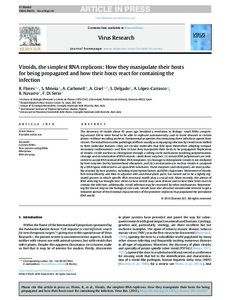| dc.contributor.author | Flores, R. |
| dc.contributor.author | Minoia, S. |
| dc.contributor.author | Carbonell, A. |
| dc.contributor.author | Gisel, A. |
| dc.contributor.author | Delgado, S. |
| dc.contributor.author | López Carrasco, A. |
| dc.contributor.author | Navarro, B. |
| dc.contributor.author | Serio, F. di |
| dc.date.accessioned | 2019-12-04T10:58:06Z |
| dc.date.available | 2019-12-04T10:58:06Z |
| dc.date.issued | 2015 |
| dc.identifier.citation | Flores, R., Minoia, S., Carbonell, A., Gisel, A., Delgado, S., López-Carrasco, A., ... & Di Serio, F. (2015). Viroids, the simplest RNA replicons: How they manipulate their hosts for being propagated and how their hosts react for containing the infection. Virus Research. |
| dc.identifier.issn | 0168-1702 |
| dc.identifier.uri | https://hdl.handle.net/20.500.12478/917 |
| dc.description | Article in press |
| dc.description.abstract | tThe discovery of viroids about 45 years ago heralded a revolution in Biology: small RNAs compris-ing around 350 nt were found to be able to replicate autonomously—and to incite diseases in certainplants—without encoding proteins, fundamental properties discriminating these infectious agents fromviruses. The initial focus on the pathological effects usually accompanying infection by viroids soon shiftedto their molecular features—they are circular molecules that fold upon themselves adopting compactsecondary conformations—and then to how they manipulate their hosts to be propagated. Replicationof viroids—in the nucleus or chloroplasts through a rolling-circle mechanism involving polymerization,cleavage and circularization of RNA strands—dealt three surprises: (i) certain RNA polymerases are redi-rected to accept RNA instead of their DNA templates, (ii) cleavage in chloroplastic viroids is not mediatedby host enzymes but by hammerhead ribozymes, and (iii) circularization in nuclear viroids is catalyzedby a DNA ligase redirected to act upon RNA substrates. These enzymes (and ribozymes) are most proba-bly assisted by host proteins, including transcription factors and RNA chaperones. Movement of viroids,first intracellularly and then to adjacent cells and distal plant parts, has turned out to be a tightly reg-ulated process in which specific RNA structural motifs play a crucial role. More recently, the advent ofRNA silencing has brought new views on how viroids may cause disease and on how their hosts react tocontain the infection; additionally, viroid infection may be restricted by other mechanisms. Represent-ing the lowest step on the biological size scale, viroids have also attracted considerable interest to get atentative picture of the essential characteristics of the primitive replicons that populated the postulatedRNA world. |
| dc.language.iso | en |
| dc.subject | G Model Virus |
| dc.title | Viroids, the simplest RNA replicons: how they manipulate their hosts for being propagated and how their hosts react for containing the infection |
| dc.type | Journal Article |
| dc.description.version | Peer Review |
| cg.contributor.affiliation | Universidad Politécnica de Valencia |
| cg.contributor.affiliation | Donald Danforth Plant Science Center |
| cg.contributor.affiliation | Tecnologie Biomediche, Bari |
| cg.contributor.affiliation | International Institute of Tropical Agriculture |
| cg.contributor.affiliation | Protezione Sostenibile delle Piante, Italia |
| cg.coverage.region | Africa South Of Sahara |
| cg.isijournal | ISI Journal |
| cg.authorship.types | CGIAR and developing country institute |
| cg.iitasubject | Plant Diseases |
| cg.iitasubject | Plant Genetic Resources |
| cg.journal | Virus Research |
| cg.howpublished | Formally Published |
| cg.accessibilitystatus | Limited Access |
| local.dspaceid | 76416 |
| cg.identifier.doi | https://dx.doi.org/10.1016/j.virusres.2015.02.027 |

